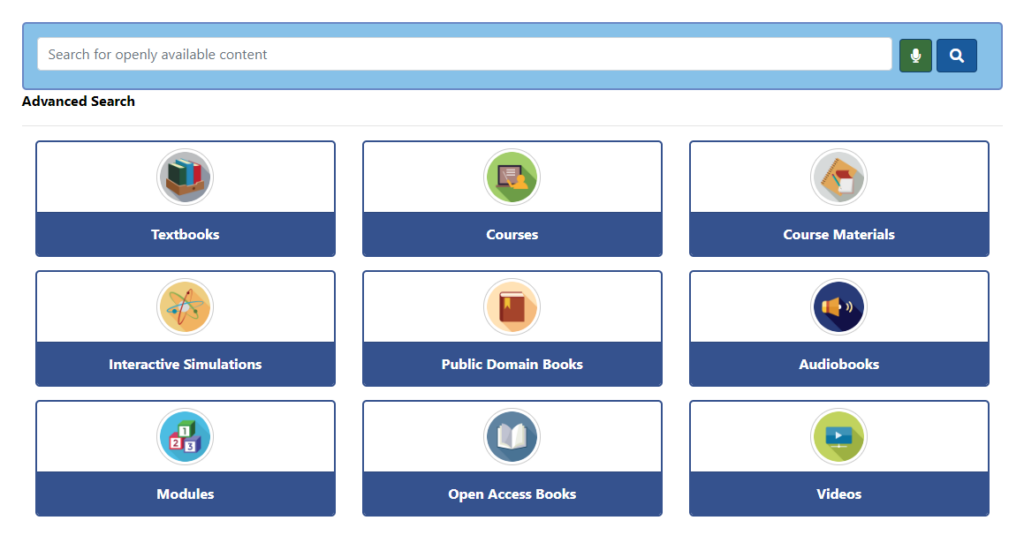Repositories and Search Tools
Learning Objectives
By the end of this section, you will be able to:
- Identify search tools for finding open educational resources.
- Identify search tools for finding openly licensed media.
- Find assistance for locating OER at SAIT.
 Scenario – Locating a Textbook
Scenario – Locating a TextbookDr. Fermin is updating her Abnormal Psychology course curriculum and would like to use an OER as the primary text. She decides to search “Canadian psychology OER” on Google to locate possible resources and finds commercial textbooks, lists of websites from libraries, links to discussion forums, and possible OER texts. Dr. Fermin isn’t sure how to sort through all of these results, and wonders if there is a better way to search. [1]
A set of available repositories, search tools, and resources are listed below to help you find the right OER for you. The following chapter will then review some strategies to use these collections effectively. Reg Erhardt Library staff can also help you identify suitable OER textbooks for your courses – you can contact your Library Liaison for more information.
Best Bets
As you’ve read previously, OER is a grassroots movement which means information and resources are dispersed across a wide range of sites. This benefits the movement, as many voices can contribute, but it also means there is no centralized repository for the works. Instead, you must first know where to find the special collections, repositories, and lists, and then search within those collections.
When starting your search for OER, it’s best to begin in a site with a wide variety of options. The websites listed below each have a different focus, but they are good places to start if you aren’t sure what to look for. A more comprehensive list of OER collections is available on the Reg Erhardt Library’s OER guide.
- The Open Textbook Library collection is a great resource for finding open textbooks. If you want a textbook and nothing more, this is the place to start.
- BCcampus Open Textbooks collects resources created, reviewed, or adopted by instructors at British Columbia universities. Materials can be filtered by Accessibility as well as whether they have been adopted by BCcampus courses, include ancillary materials, or have been reviewed by faculty.
- MERLOT provides access to a curated collection of open and accessible learning materials in a wide range of formats.
- BCcampus also has a list of the most popular OER repositories in Canada and the United States.
Federated Search Tools

SUNY’s Openly Available Sources Integrated Search (OASIS)
OASIS is a search tool that aims to make discovery easier by searching multiple sources for OER and other open content at once. It currently searches 79 different sources and contains approximately 330,000 records.
George Mason OER Metafinder (MOM)
MOM links to a wide array of open content, including open access books and articles, documents in the public domain, and OER. Because of its large breadth of resources, we recommend that you start your MOM search with only a selection of the “OER-specific sites” checked, rather than all the materials it can include.
Institutional Collections
Institutional repositories (IRs) aren’t just for sharing copies of research articles and student theses. They can also be used to store and share OER. Although not every college shares OER through their institutional repository, the colleges below do share collections of OER specific to their institution:
- University of Saskatchewan Open Textbook Catalogue
- OpenMichigan (University of Michigan)
- MIT OpenCourseWare (Massachusetts Institute of Technology)
Subject-specific Repositories
Some OER are shared through subject-specific repositories. A few notable examples of this type, including open publishers that specialize in one discipline, are listed below:
- Chem Collective: Chemistry
- Learn Chem E: Chemical Engineering
- Noba Project Psychology Modules: Psychology
- Center for Open Educational Resources and Language Learning (COERLL): Languages
- Open Geography Education: Geography
- Engineering Technology Simulations: Engineering, Physics
- PhET Simulations: Physics, Physical science, Geology, Chemistry
- SkillsCommons: Career & Technical Education (CTE)
- Green Tea Press Textbooks: Computer Science, Programming (Bayes, Python, MATLAB, Java, DSP)
OER by Course
Some colleges choose to share information about which OER their instructors assign in courses. These lists can give you a good idea of what other instructors in your discipline have adopted and (if they have provided a review), what they think of their adopted resource.
- COOL4ED Faculty Showcase (California universities and colleges)
- Open Oregon Educational Resources (Oregon universities and colleges)
Open Content (not explicitly OER)
Not all open content is made to be used in the classroom, but that doesn’t mean you can’t integrate them into your course. Open access book chapters and openly-licensed media can be great additions to your course.
Open Access Publishers and Repositories
- Directory of Open Access Journals (DOAJ) Open Access journal articles
- Directory of Open Access Books (DOAB) Open Access books
- Project Gutenberg Public domain books and documents
- PubMed Open access journal articles
- Public Library of Science (PLoS) Open access journal publisher
- Open Book Publishers Open access book publisher
CC-licensed Media
The Reg Erhardt Library’s Finding and Using Images guide has an extensive list of open licensed and public domain image collections. Resources for other forms of media include:
- CC Search A federated search tool for finding content available under a CC license
- Digital Public Library of America (DPLA) Public domain images, videos, recordings, and texts
- The Metropolitan Museum of Art High-quality open images from the Met
- Youtube Videos. Use the Filters option on the results screen to select Creative Commons
- Free Music Archive Public domain and CC-licensed music and sound bytes
- This scenario is used under at CC BY 4.0 licence from University of British Columbia. https://pose.open.ubc.ca/open-education/oer/adapting-an-existing-resource/ ↵
A model by which content creators make their scholarly outputs free to access without cost to users. This can be done either by publishing content with an OA publisher or by sharing a copy of the content on an open repository.
A copyright license which grants permission for all users to access, reuse, and redistribute a work with few or no restrictions.

